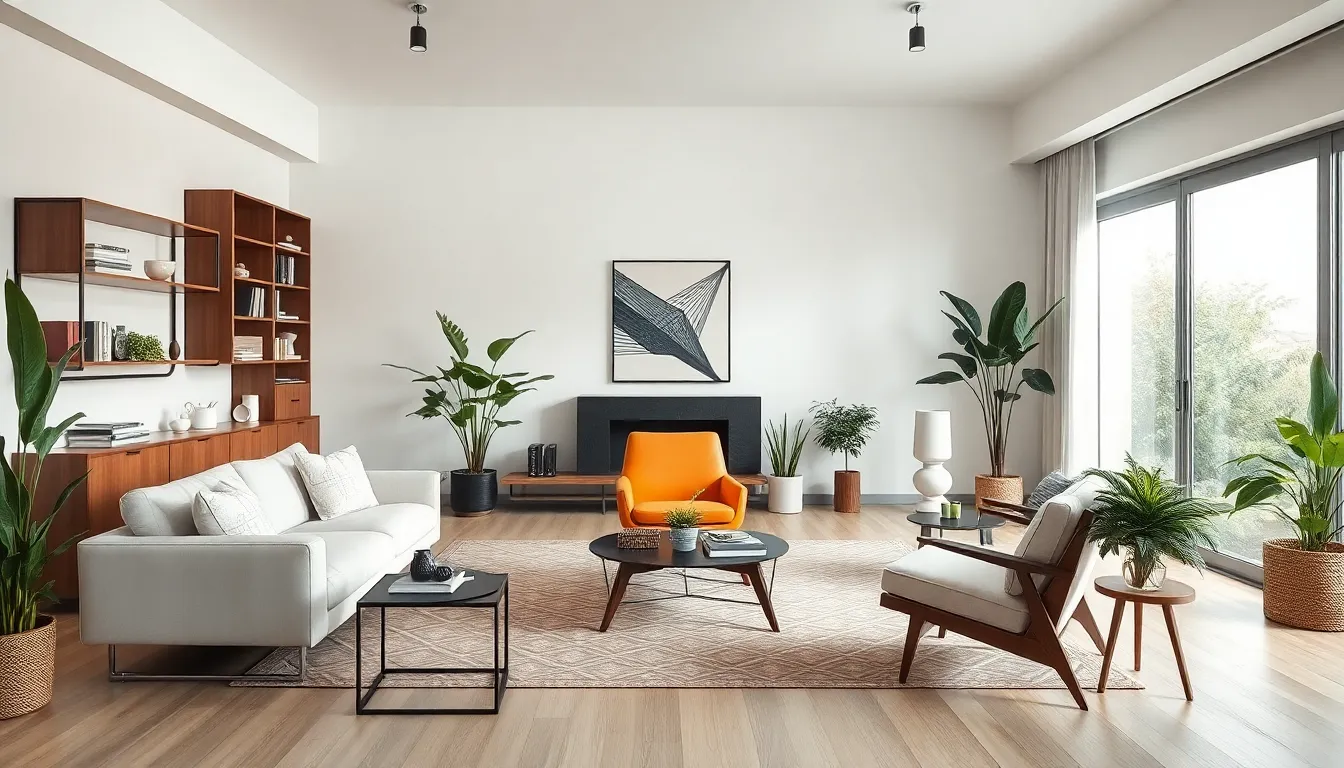When it comes to interior makeovers, the difference between a dull space and a stunning sanctuary often boils down to a splash of creativity and a dash of courage. Whether it’s transforming a cramped apartment into a cozy haven or turning a bland office into a vibrant workspace, the right makeover can breathe life into any environment. Who knew that a few strategically placed throw pillows and a gallon of paint could spark so much joy?
Table of Contents
ToggleWhat Are Interior Makeovers?
Interior makeovers refer to the process of revitalizing and enhancing indoor spaces. They involve strategic design changes aimed at improving aesthetics and functionality in homes or offices. This transformation can include simple tasks like rearranging furniture, applying a fresh coat of paint, or adding decorative elements.
Creative solutions bring energy to any interior. By selecting bold color palettes or unique textures, one can completely alter a room’s ambiance. Curtains, artwork, and lighting fixtures often contribute to a space’s overall feel. Upgrading furniture, switching out accessories, or incorporating plants can additionally breathe life into dull environments.
Various aspects define successful interior makeovers. These can encompass spatial planning, color theory, and the effective use of materials. Each element contributes to creating a cohesive and practical environment. Patterns play a significant role too; mixing different designs can add depth and interest, as long as harmony is maintained.
Strategic positioning of furniture promotes flow and enhances usability. Before starting a makeover, assessing the area’s needs helps guide the design process. Looming clutter detracts from a space’s appeal, so decluttering is often essential before introducing new concepts.
Ultimately, interior makeovers create inviting atmospheres. By combining creativity with practical applications, one’s space can evolve dramatically. This transformation ensures spaces reflect their occupants’ personalities, making interiors not just visually pleasing but also functional and welcoming.
Popular Interior Makeover Trends

Interior makeovers incorporate a variety of trends that enhance visual appeal and functionality. Current styles merge aesthetics with innovation, ensuring spaces remain relevant and inviting.
Minimalist Design
Minimalist design emphasizes simplicity and functionality. Clean lines and uncluttered spaces create a sense of calm. Neutral color palettes dominate, allowing natural light to enhance ambient warmth. Essential furniture pieces include low-profile sofas, modular shelving units, and elegant accent tables. Open floor plans often feature prominently, promoting a flowing feel while reducing distractions. This trend encourages mindful consumption, focusing on quality over quantity.
Vintage Revivals
Vintage revivals celebrate timeworn elegance and nostalgic charm. Incorporating mid-century modern pieces alongside classic antiques injects personality into interiors. Colorful retro furnishings can serve as striking conversation starters. Patterns, such as geometric and floral, often feature in textiles and wallpapers. Unique finds from thrift stores or estate sales enhance authenticity, embodying the richness of history. Layering vintage pieces with contemporary elements fosters a balanced, curated aesthetic.
Eco-Friendly Approaches
Eco-friendly approaches prioritize sustainability in interior makeovers. Reclaimed materials and low-VOC paints reduce environmental impact. Natural fibers, such as jute and organic cotton, create earthy textures while promoting health-conscious living. Energy-efficient lighting solutions enhance ambiance without increasing utility costs. Indoor plants improve air quality and add vibrant color, contributing to a serene atmosphere. Prioritizing sustainable design not only benefits the environment but also creates inviting, healthy spaces.
Essential Elements of a Successful Makeover
Successful interior makeovers rely on a few key elements that enhance aesthetics and functionality. Each aspect—color schemes, furniture selection, and lighting techniques—plays a distinct role in transforming a space.
Color Schemes
Color schemes dramatically influence a room’s mood. Choosing the right palette can create a cohesive look or evoke specific emotions. Neutral tones, such as grays and beiges, provide a calming backdrop, while bold colors add vibrancy and energy. Combining several shades within a defined palette enhances visual interest. To achieve harmony, consider the room’s purpose when selecting colors. For example, warmer shades encourage conversation in dining areas, while cooler tones promote relaxation in bedrooms.
Furniture Selection
Selecting the right furniture affects both functionality and comfort. It’s vital to choose pieces that align with the room’s size and layout. Oversized furniture often overwhelms a small space, while appropriately scaled items maximize usability. Combining different styles, such as modern and vintage, adds personality to the interior. Selecting multipurpose furniture, like ottomans that double as storage, increases space efficiency. Comfort and quality should also guide choices, as well-built pieces last longer and maintain aesthetic appeal.
Lighting Techniques
Lighting enhances the ambiance of any interior. Layering different light sources—ambient, task, and accent—creates depth and warmth. Natural light should be maximized by using mirrors or sheer curtains. Dimming fixtures allow for flexibility in mood settings. Pendant lights can serve as focal points over dining tables, while wall sconces add elegance to hallways. Incorporating smart lighting solutions can provide convenience and adaptability, ensuring that each area shines just right.
DIY vs. Professional Makeovers
Choosing between DIY and professional makeovers impacts both outcomes and costs. DIY projects offer flexibility, allowing individuals to tackle tasks based on personal schedules. Popular choices include painting, furniture rearrangement, and simple decor updates. Many enjoy the satisfaction of transforming spaces independently, often resulting in cost savings.
Professional makeovers provide expertise, ensuring high-quality results. Designers understand spatial planning, color theory, and the effective use of materials. Working within specific budgets, professionals streamline the renovation process and provide innovative solutions not easily replicated in DIY projects. They bring an artistic vision that enhances aesthetics and functionality, often resulting in a cohesive design style.
Project scale influences the decision-making process. Smaller tasks, like room refreshes, often fit DIY approaches, while larger undertakings, such as full renovations, may benefit from professional guidance. Time constraints also play a critical role; busy individuals may prefer hiring experts to achieve their desired outcomes efficiently.
Budget considerations impact decisions as well. Complete design services tend to incur higher costs, though they may save time and reduce errors. DIY projects typically involve minimal expenses, although they require time and effort. Understanding personal capabilities also aids in making informed decisions.
Ultimately, both approaches offer unique advantages. Combining DIY elements with professional help creates a hybrid approach that maximizes results. Selecting the right path ultimately depends on personal preferences, specific project demands, and individual skill levels.
Transforming interior spaces is a journey of creativity and personal expression. By embracing bold colors and innovative designs, anyone can create an inviting atmosphere that resonates with their unique style. Whether opting for a DIY approach or enlisting professional help, the key lies in understanding the balance between aesthetics and functionality.
As trends evolve, staying informed about new ideas and techniques can inspire fresh makeovers that breathe life into any environment. Ultimately, interior makeovers not only enhance visual appeal but also foster a sense of well-being, making spaces feel truly like home.





